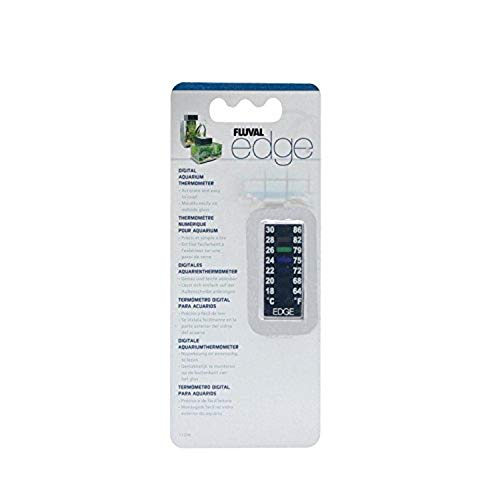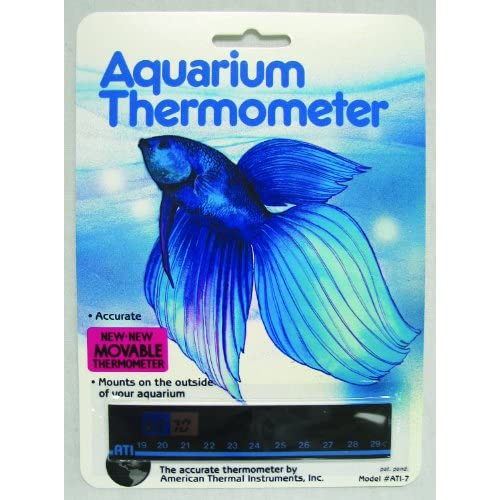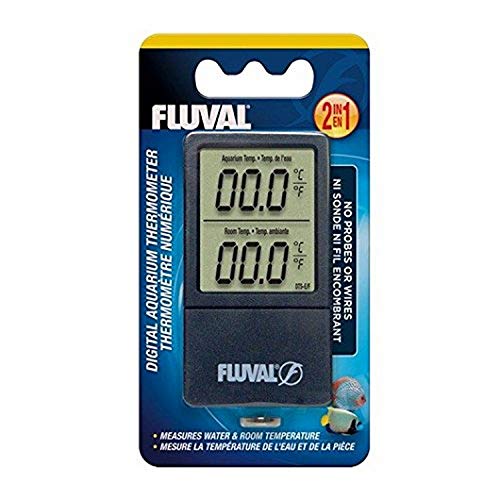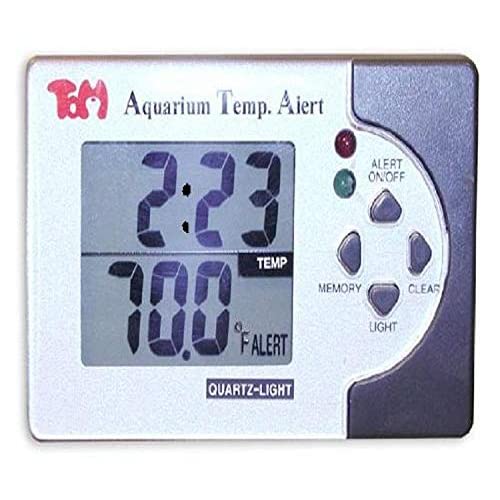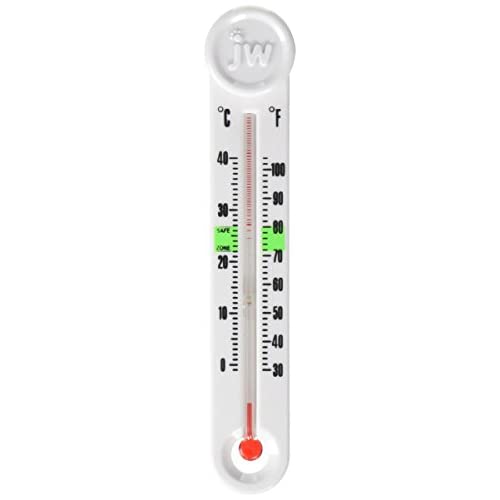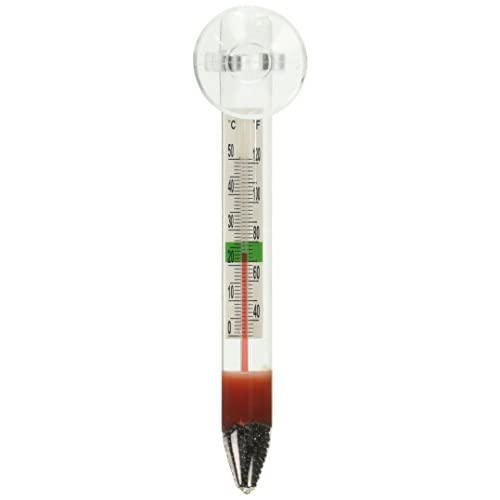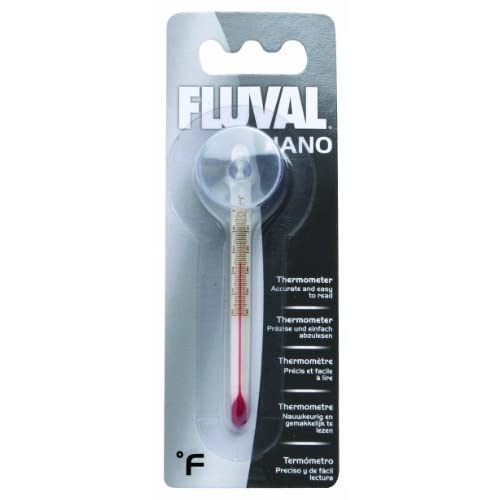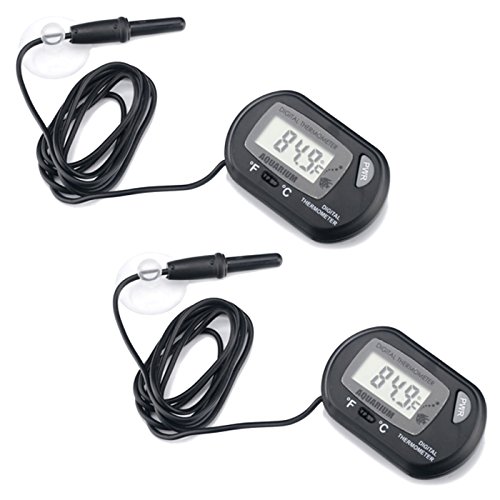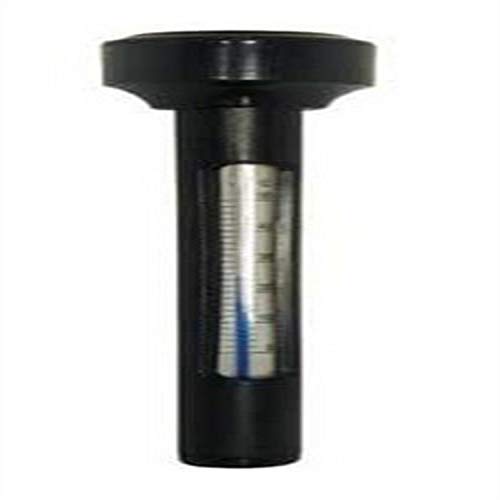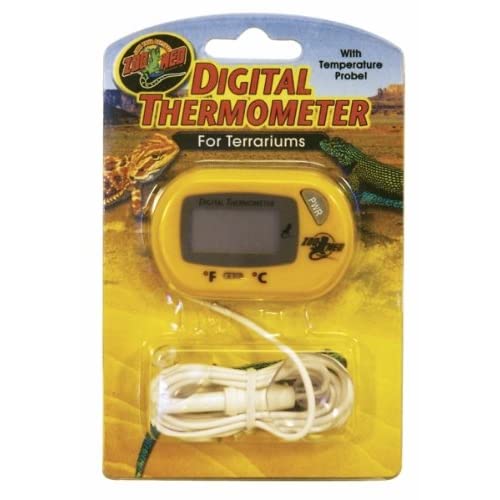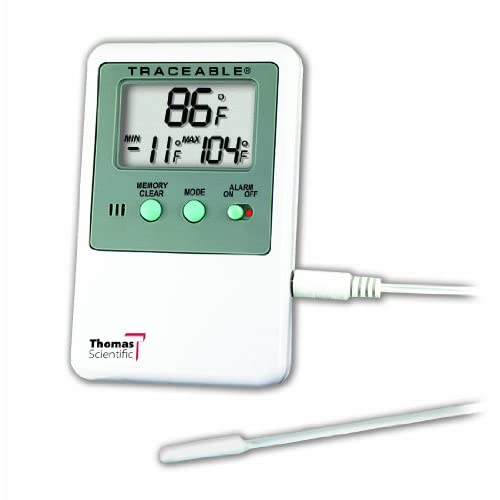An aquarium thermometer is an inexpensive investment to care for your fish properly. It’s essential to keeping the tank inhabitants healthy and comfortable. And you can choose from a variety of styles to suit your aquarium setup.
Top aquarium thermometers
We’re going to review the best aquarium thermometers first. Then we’ll discuss the pros and cons of the different types.
#1 Fluval EDGE Digital Aquarium Thermometer
Fluval’s Tiny EDGE thermometer is a good choice for small tanks like betta fish aquariums. It’s only 1.75-inches tall, and it sticks to the outside of the tank. While it’s not as precise as some thermometers, it’s easy to use and safe enough for fish that tolerate some fluctuation in temperature.
With the EDGE, you can see at a glance if the water temperature is acceptable based on the color it shows. Green is good, while tan and blue mean the water is out of the optimum range. It displays temperatures from 64 to 86 degrees Fahrenheit, so it’s appropriate for both saltwater and freshwater fish.
#2 American Thermal Liquid Crystal Aquarium Thermometer Horizontal
Another inexpensive and relatively accurate stick-on thermometer is this one from American Thermal. You can reposition it on the outside of the tank to view the temperatures at the top and the bottom of the water. That’s important because there’s usually a difference that could affect your fish depending on where they prefer to spend their time.
The 4-inch long horizontal display shows green when the conditions are good, then tan for too low and violet for too high.
#3 Fluval Wireless 2in1 Digital Thermometer
If a sticker thermometer isn’t accurate enough for your needs, try the 2-in-1 Wireless model from Fluval. It measures both tank water and room air temperature without the need for probes or wires. All you need to do it mount it on the outside of your aquarium. Plus, the large LCD is easy to read from a distance although it has no backlight for night-time readings.
#4 KollerCraft TOM Temp Alert Digital Thermometer for Aquariums
Let’s take another step up in accuracy and look at the KollerCraft TOM Temp Alert Thermometer. It comes with a probe on a three-foot-long cord with a suction cup to mount it inside your aquarium. Then the body of the thermometer with the display remains outside the tank. It works in both saltwater and freshwater, too.
The advantages of the TOM Temp Alert model are that it has an audible alarm as well as an LED light that warn when the water temperature goes out of the ideal range. And that range is preset to 75 to 82 degrees Fahrenheit. Should the alert occur while you are not at home, you can view the time stamp to see when it happened.
#5 JW Pet Company Smarttemp Thermometer Aquarium Accessory
The JW Pet Company’s Smarttemp Thermometer is nice for acrylic tanks because it does not use a suction cup for mounting. Sometimes suction cups permanently mark acrylic. Instead, the Smarttemp comes with a magnet that allows you to reposition the thermometer easily.
The manufacturer says the thermometer has been tested to be accurate within plus or minus 4.5 degrees F. It has large number plus a green zone for quick readings.
If you prefer a non-magnetic version, the same thermometer is available in a weighted standing version. This is handy for testing the cooler water on the bottom of the tank.
#6 Marina Floating Thermometer with Suction Cup
Marina’s Floating Thermometer is just over four inches tall. You can secure it inside the tank with its suction cup, or you can let it float freely. Owners have commented that the weighted end keeps the thermometer vertical in the water with its top at the surface. The safety zone indicator lets you see at a glance if the water temperature is safe.
#7 Fluval Nano Thermometer
Fluval’s Nano Thermometer is small, but its range is immense. It measures temperatures between 35 to 125 degrees F, more than enough for a wide variety of aquatic animals and plants. You can mount it inside the water with the included suction cups.
#8 HDE Digital Aquarium Thermometer
HDE’s Digital Thermometer comes with a submersible probe. The advantage of this type of thermometer is that you can easily measure the temperatures of different parts of the tank.
HDE says that this model is accurate down to 0.1 degrees and it measures from -58 degrees F to 158 F. That’s overkill when most fish prefer 74 to 82 F, but it’s handy all the same. And you can switch to Celsius readings if you prefer.
The thermometer comes with an LR44 coin cell battery and suction cups. Mount the display anywhere you like outside the tank.
#9 Danner 02399 Floating Pond Thermometer
Danner’s 02399 Thermometer is made for floating in an outdoor pond, but you can use it inside an aquarium, too. It shows the temperature in both Celsius and Fahrenheit. And it comes with a tether to keep it in place.
#10 Zoo Med Digital Thermometer
If you have tank inhabitants that move in and out of the water, try Zoo Med’s Digital Thermometer. Its external probe is submersible. And the temperature range of 10 to 140 F is adequate for a wide range of animals, from cold water fish to reptiles.
#11 Thomas 8601 Temperature Alarm
If accuracy is paramount, take a look at the Thomas 8601 Temperature Alarm. It’s an industrial and scientific tool that measures both air and water temperatures within -58 to 158 F, and it’s accurate down to plus or minus 1 degree Celsius. Just insert the submersible probe inside the tank, and you’re ready to take readings.
While it comes calibrated from the factory, it’s a tool that you can recalibrate yourself. And you can program it with an alarm for when the temperature goes out of the ideal range you’ve chosen. The LCD has half-inch tall numbers so that you can read it from a few feet away. And the ten-foot-long probe means you can mount the display a considerable distance away from the tank.
The best temperatures for various kinds of tank inhabitants
First off, cold water coming from the faucet in your home might be as chilly as 55 F. That’s too cold for most kinds of fish. Even goldfish and bettas need temperatures in the seventies. Here’s a rundown of the most common tank inhabitants and the temps they need:
- Goldfish–68 to 72 F
- Shrimp—57-84 F, but prefer 72 F
- Betta fish—74 to 80 F, with a preference for 78 F
- Tetras—75 to 78 F
- Freshwater tropical fish—76 to 80F
- Saltwater tropical fish—75 to 80 F
- Coral—80 F
If you have a thermometer, you can check the clean water before you add it to the tank to avoid shocking the fish. And you can also monitor conditions in the aquarium to avoid ending up with sick fish.
Conditions that affect the temperature of the water
Many different things can affect the temperature of the water inside an aquarium. For example, a heater is designed to do exactly that. But the tank lighting can also make a difference. And so can the air temperature of the room where the aquarium is located.
If the tank receives direct sunlight or drafts of air, that changes the temperature. And water changes also have a big impact.
Some kinds of fish and aquatic plants tolerate temperature changes better than others do. And if you have a planted tank with different kinds of inhabitants, it might seem difficult to make everyone happy at the same time. That’s why it’s important to plan before you add new fish or plants to an aquarium.
If you find that the tank’s water is too warm, you can add colder water a little at a time. Increasing the flow of water inside the tank helps, too. And if the temperature’s too low, add another heater or adjust the one you have if you can.
Different types of thermometers
As you saw in the reviews above, there are three main kinds of thermometers for aquariums. Here are the pros and cons of each type.
Stick-on thermometers
If an approximate reading is close enough, you might be satisfied with a stick-on thermometer that has a liquid crystal display. It’s cheap, and there are no batteries to replace. Typically this kind changes color to reflect the water temperature inside the tank so you can check conditions with a quick glance.
As long as you don’t place the strip where it’s impacted by direct sunlight or air currents, it should report a relatively correct temperature.
Submersible internal standing or floating thermometers
Putting the thermometer into the water is a better way of detecting the actual temperature. Simple submersible thermometers are generally a solid choice. Many have suction cups to stay in place, and others are weighted to stand on the bottom of the tank. Some might float on the surface. But again, these are generally inexpensive, and they operate without batteries.
The downsides to submersible thermometers are that they tend to be harder to read and some kinds are fragile.
Digital thermometers
Digital thermometers are the most accurate, and they often have additional features that make them more attractive to the serious aquarist. They consist of a display and a submersible probe. Most operate on batteries, but some might plug into a wall socket for power.
With a digital thermometer, you can quickly monitor various parts of the tank by moving the probe. And the LCD on most models tends to be large and clear for easy reading.
Some types of digital thermometers have alert signals to warn when the water temperature is not ideal. High-end models will allow you to program this feature. The only cons are that this type of thermometer generally costs more to buy and to operate since it will need replacement batteries in the future.
How to manage tank temperature when the power goes out?
Let’s hope that you have a thermometer that doesn’t need mains electricity. If the power goes out, you’ll want to check the tank water more frequently. Once the filtration system stops and the heater stops running, your fish are at risk.
You can cool down the tank by adding cold water a little at a time. Be sure to treat it with dechlorinator if it’s straight from the tap. And you can heat up the tank the same way with warm water. But some aquarists float sealed containers with the hot or cold water inside instead of adding fresh water to the aquarium. Just refill the containers when their effect lessens.
You can also add oxygen to the water by using a clean cup to scoop up some from the tank, then pour it back inside over and over.
Conclusion
An aquarium thermometer is an inexpensive purchase that protects the well-being of your fish and aquatic plants. Choose from stick-on, submersible, and digital thermometers to meet the needs of your tank’s inhabitants. It’s well worth the small effort it takes to measure the temperature on a regular basis.
